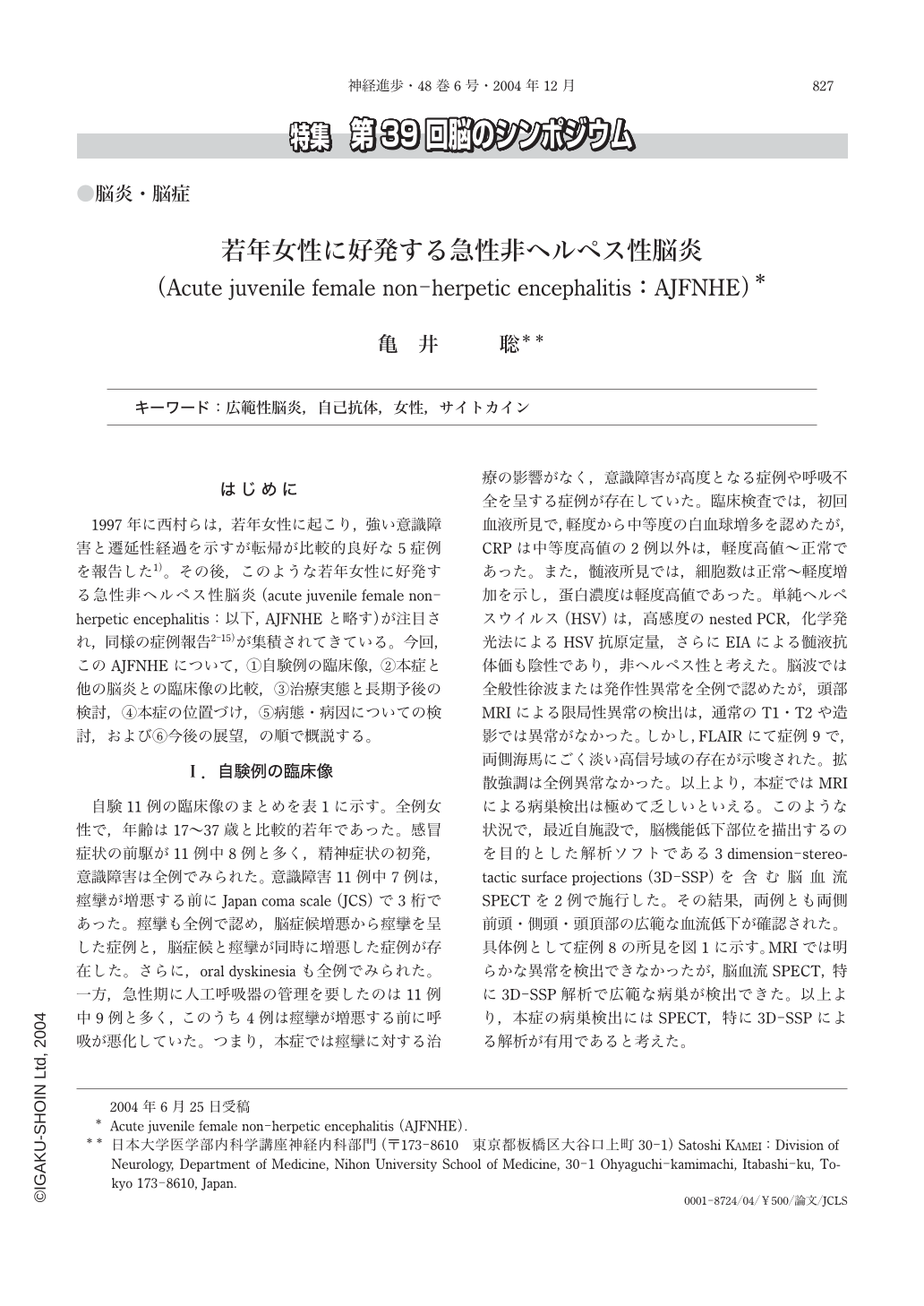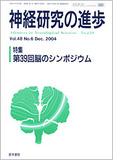Japanese
English
- 有料閲覧
- Abstract 文献概要
- 1ページ目 Look Inside
1997年に西村らは,若年女性に起こり,強い意識障害と遷延性経過を示すが転帰が比較的良好な5症例を報告した1)。その後,このような若年女性に好発する急性非ヘルペス性脳炎(acute juvenile female non-herpetic encephalitis:以下,AJFNHEと略す)が注目され,同様の症例報告2-15)が集積されてきている。今回,このAJFNHEについて,①自験例の臨床像,②本症と他の脳炎との臨床像の比較,③治療実態と長期予後の検討,④本症の位置づけ,⑤病態・病因についての検討,および⑥今後の展望,の順で概説する。
Our recent work on AJFNHE is reviewed based on clinical studies of 11 of our patients.
In 1997, T. Nishimura of our institute first reported five juvenile female patients with acute non-herpetic encephalitis who presented with severe prolonged coma and status epilepticus, but achieved good recovery. Following this report, there have been about 35 other case reports of AJFNHE. The characteristics of AJFNHE were found to be as follows:(1)a clinical profile of encephalitis on admission developing with psychosis, disturbance of consciousness, and/or convulsions, (2)progression to coma and status epilepticus following admission, and frequent episodes of attachment to a respirator due to respiratory failure, (3)a prolonged clinical course without significant effects of treatments including aciclovir and corticosteroid administration, (4)a good outcome in the long term despite a markedly severe clinical course at the acute stage, (5)a predilection for juvenile females, (6)a lack of abnormal intensity on cranial MRI, and(7)negative results for herpes simplex virus(HSV)infection employing the nested PCR and EIA.
Based on the clinical studies undertaken in our 11 patients with AJFNHE, it became first clear that three dimension-stereotactic surface projections(3D-SSP)on single photon emission computed tomography(SPECT)could detect diffuse lesions of which were distributed from the bilateral frontal, temporal areas to parietal areas.
These patients could be successfully cured by intensive care, but it is thought impossible to achieve a cure under former levels of medical treatment. In this context, when previous neuropathological reports on encephalitis were examined,the“acute diffuse lymphocytic encephalitis(ADLE)”described by R. Iizuka(1965)was found to be very similar in its clinical characteristics to AJFNHE. The pathological characteristics of ADLE could be summarized as follows:(1)mild neuropathological findings comparison with a severe clinical condition, (2)diffuse lymphocytic infiltration distributed to bilateral frontal lobes, temporal lobes, parietal lobes, hippocampus, thalamus, and basal ganglia, (3)mild gliosis, (4)a lack of perivascular demyelination, and(5)preservation of neural cells. Finding(4)of ADLE was in concordance with a lack of abnormal intensity on brain MRI that would indicate demyelination as in acute disseminated encephalomyelitis. Finding(5)of ADLE was also in concordance with finding(4)of AJFNHE. Moreover, finding(2)of ADLE was very similar to the distribution of lesions in our cases of AJFNHE using 3D-SSP analysis in SPECT examinations.
Our investigations of the etiology of AJFNHE have revealed that autoantibodies to glutamate receptors GluRε2 andδ2 were frequently detectable in the cerebrospinal fluid of patients with AJFNHE, and the intrathecal concentration of interleukin-6 was mildly increased in all of our patients. These findings suggest that in the etiology of AJFNHE, autoantibodies including GluR might play a role in diffuse brain hypofunction and underlie the severe and prolonged clinical course, with acceleration of T cells via a host-immune response against some viral infection to the central nervous system.

Copyright © 2004, Igaku-Shoin Ltd. All rights reserved.


